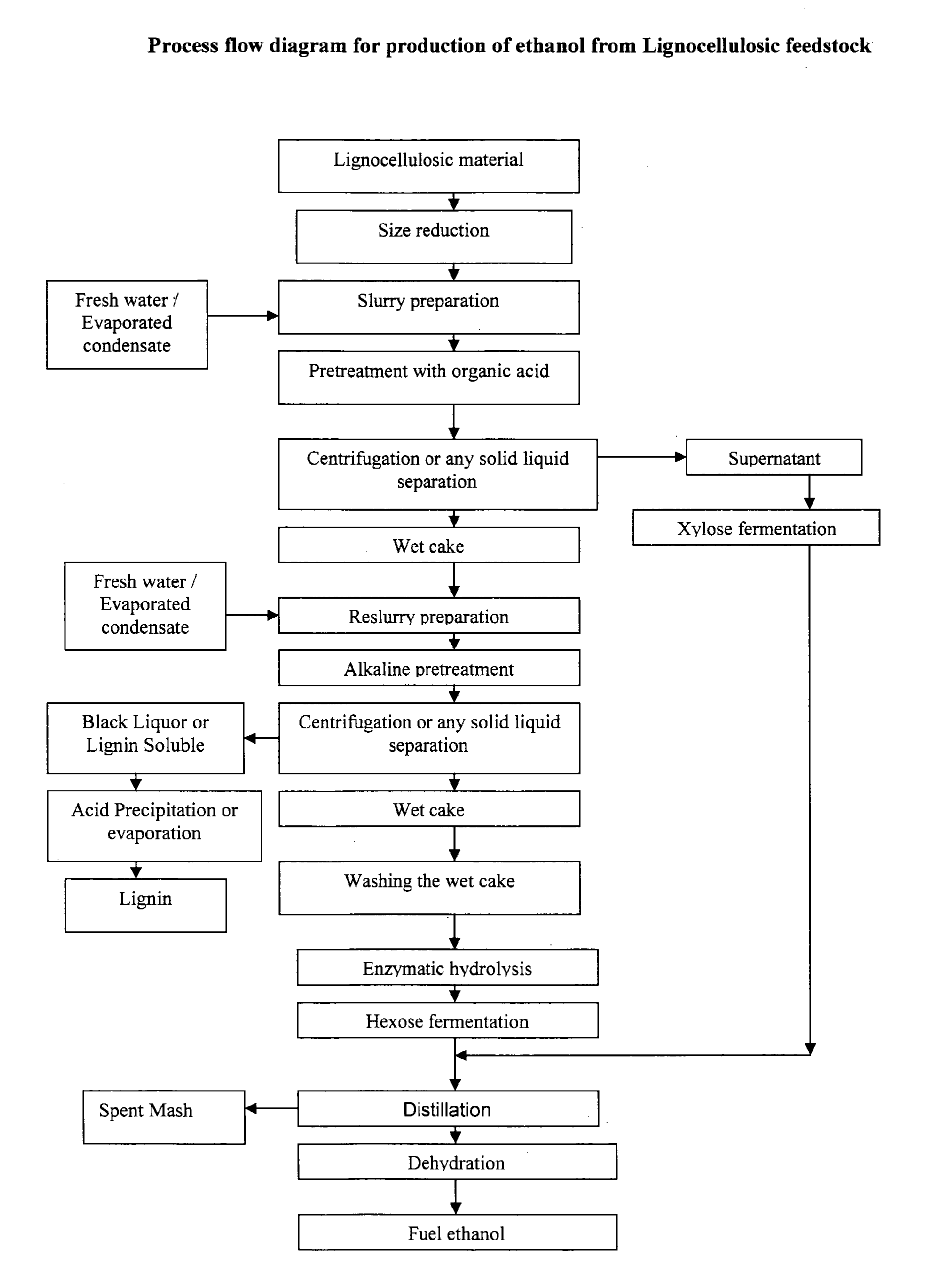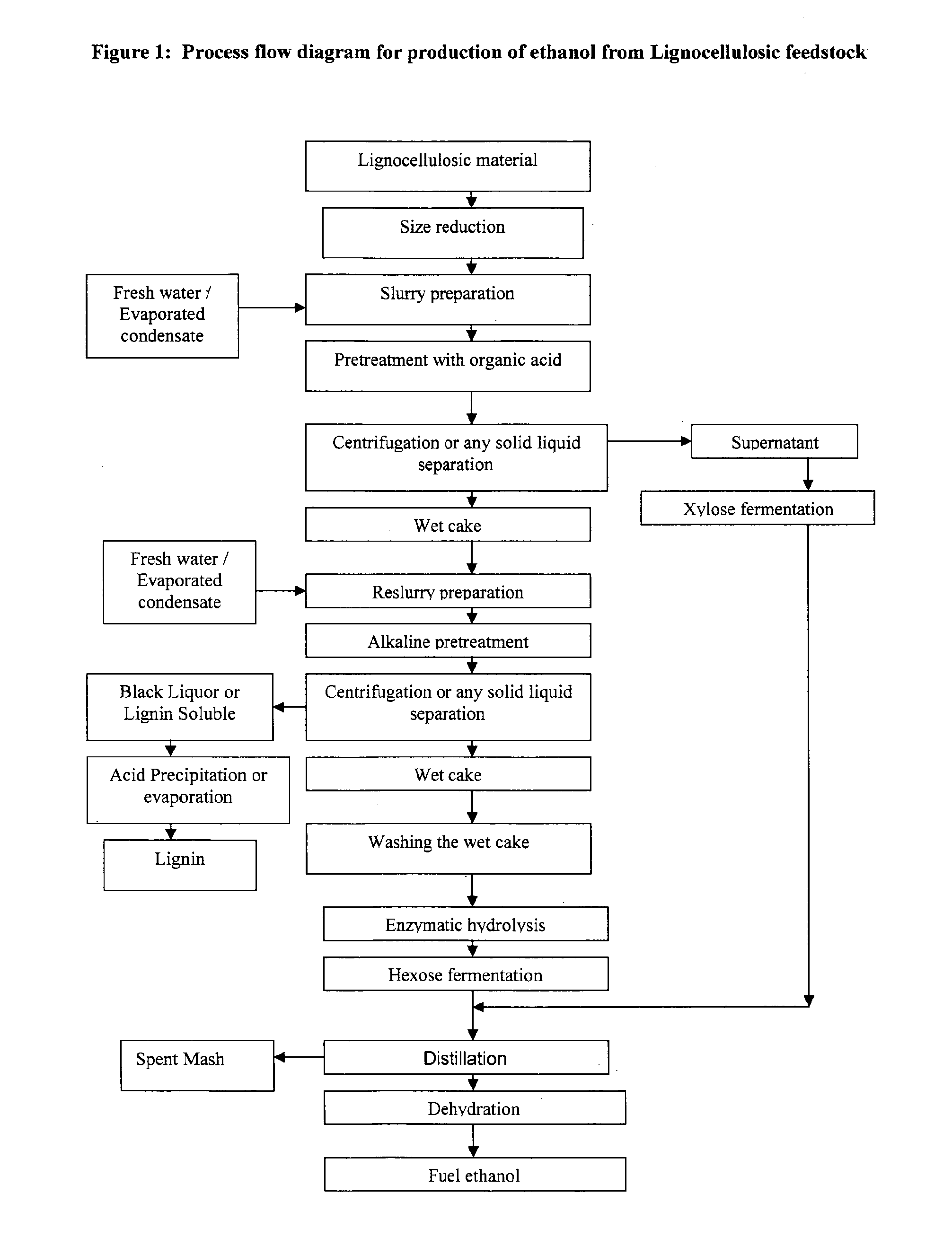Process for Production of Ethanol from Lignocellulosic Material
a technology of lignocellulosic material and ethanol, which is applied in the direction of biofuels, fermentation, etc., can solve the problems of rigid structure, high cost, and high cost compared to cost, and achieve the effect of effective and economical process
- Summary
- Abstract
- Description
- Claims
- Application Information
AI Technical Summary
Benefits of technology
Problems solved by technology
Method used
Image
Examples
examples
[0031]The invention will now be illustrated with working examples. It is to be understood that the working examples illustrate the working of the process of the invention and are not intended to be taken restrictively to imply any limitation on the scope of the present invention. In the examples given, the feed stocks used are Sugar Cane or Sweet sorghum Bagasse, Corn Stover, Corn Cob, Grass, Distillers Dried Grains and Soluble (DDGS), and Distillers Wet Grains (DWG)
example-i
Sugar Cane Bagasse as Feed Stock
[0032]10 kilograms of Cane Bagasse having moisture content in the range of about 5% to about 10% is subjected to mechanical action for size reduction to about 2 mm to about 20 mm having solid content of about 85% to about 95% by weight followed by addition of about 9234 grams of fresh water or recycled condensate from the evaporation step to the bagasse pieces so as to obtain a slurry. The total solids content in the slurry is about 6.0% by weight. The slurry is mixed with about 100 grams of oxalic acid was such that the concentration of organic acid present in the slurry is about 0.1% to about 2.0% by weight. The mixing is carried out in combination with heating at a temperature about 150° C. for a period of about 45 minutes. After the oxalic acid treatment, the slurry was subjected to filtration / centrifugation for the separation of the hemicellulose rich supernatant which is further fed for fermentation. The cake left after filtration is reslurried ...
example-ii
Using Grass as Feed Stock
[0033]10 kilograms of grass having moisture content of about 50% to about 60% by weight is subjected to a mechanical action for size reduction to about 2 mm to 20 mm using shredder having solid contents in the range of about 40% to about 50%, followed by addition of about 5000 grams of fresh water or recycled condensate from the evaporation step so as to obtain slurry. The total solids content in the slurry obtained is about 6.0% by weight. The slurry is mixed with about 100 grams of oxalic acid such that the concentration of organic acid present in the slurry is about 0.1 to about 2.0% by weight. The mixing is carried out in combination with heating at a temperature about 130° C. for a period of about 60 minutes. After the oxalic acid treatment, the slurry was subjected to filtration / centrifugation for the separation of the hemicellulose rich supernatant which is further fed for fermentation. The cake left after filtration is reslurried by using recycled wa...
PUM
| Property | Measurement | Unit |
|---|---|---|
| size | aaaaa | aaaaa |
| temperature | aaaaa | aaaaa |
| temperature | aaaaa | aaaaa |
Abstract
Description
Claims
Application Information
 Login to View More
Login to View More - R&D
- Intellectual Property
- Life Sciences
- Materials
- Tech Scout
- Unparalleled Data Quality
- Higher Quality Content
- 60% Fewer Hallucinations
Browse by: Latest US Patents, China's latest patents, Technical Efficacy Thesaurus, Application Domain, Technology Topic, Popular Technical Reports.
© 2025 PatSnap. All rights reserved.Legal|Privacy policy|Modern Slavery Act Transparency Statement|Sitemap|About US| Contact US: help@patsnap.com


